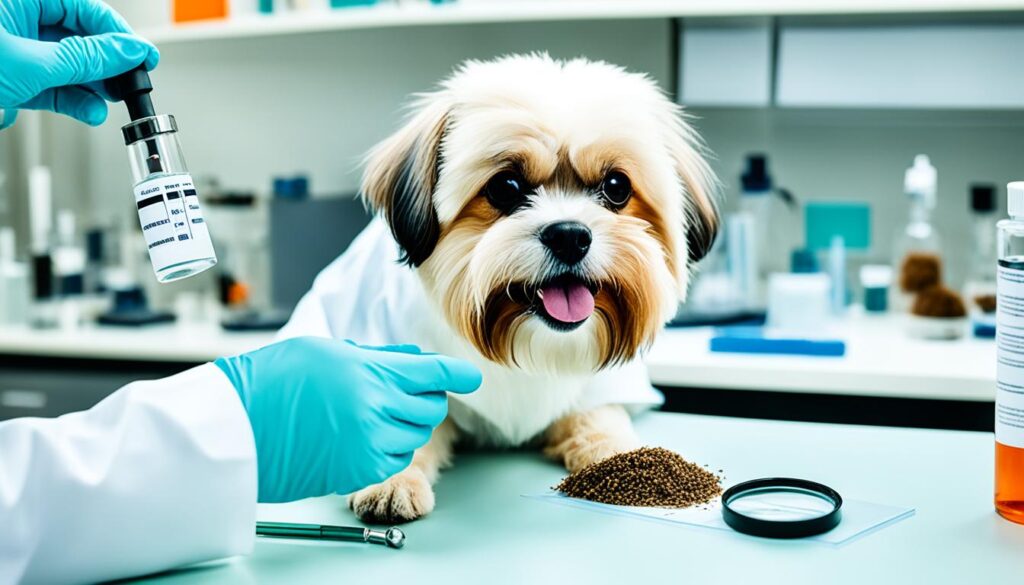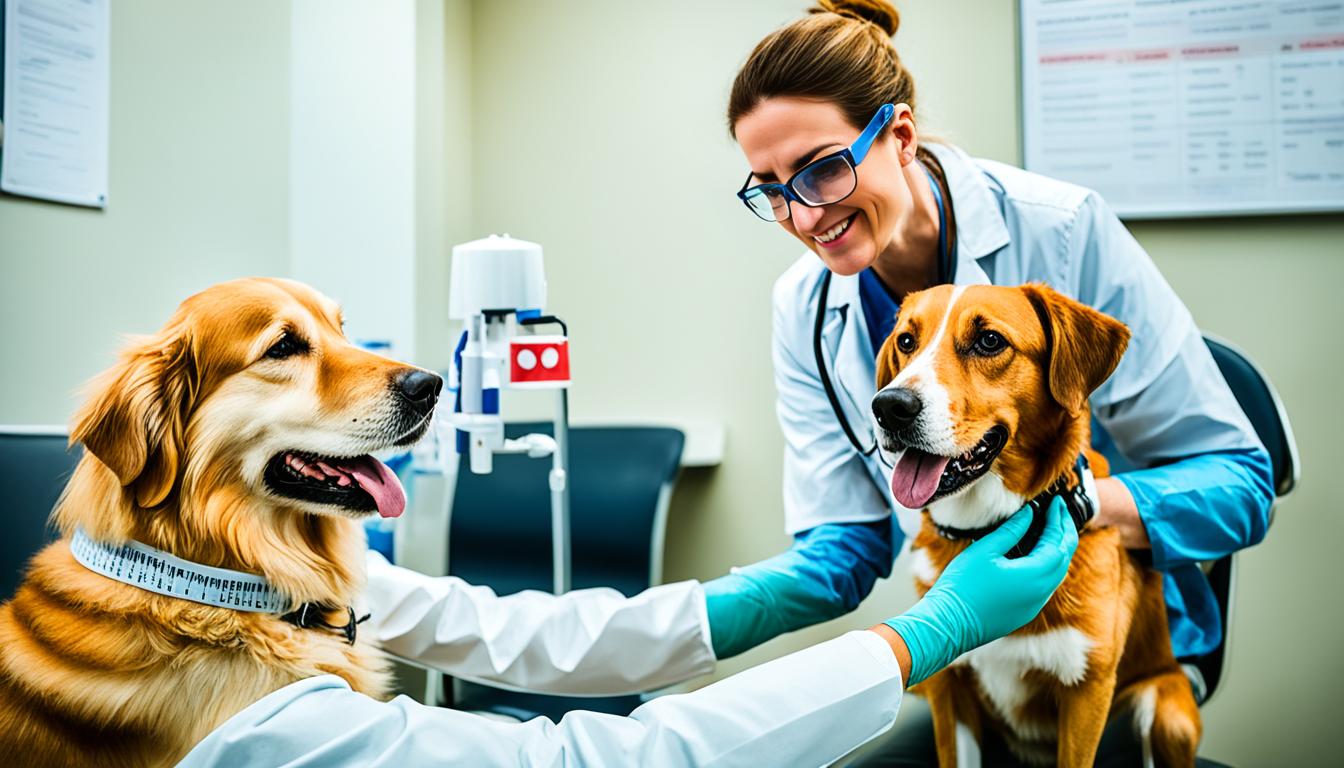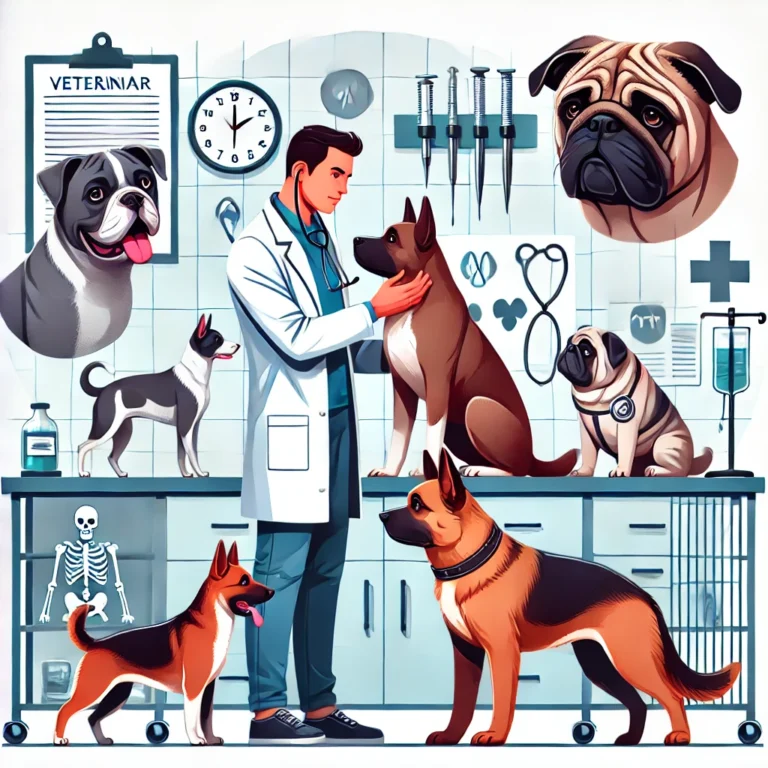how dog allergies are treated
Is your furry friend always scratching, sneezing, or having tummy troubles? These could mean they have dog allergies. Many dogs get allergies, making them visit the vet often1. But what can we do to help our pets feel better?
Dog allergy treatment depends on the allergy type and how bad it is. Skin allergies are the most common in dogs2. They can come from things in the environment, food, or even fleas. To help dogs, we might avoid allergens, use medicine, and change their lifestyle.
Dogs can show allergies in many ways, like itchy skin, breathing problems, or upset stomach. Knowing these signs is key to helping them feel better1. Let’s look at the different allergies dogs can get and how we can treat them.
Key Takeaways
- Dog allergies are a common issue affecting many canines
- Allergic dermatitis is the most frequent type of allergic reaction in dogs
- Treatment approaches vary based on allergy type and severity
- A combination of avoidance, medication, and lifestyle changes is often effective
- Understanding allergy symptoms is crucial for proper management
- Consultation with a veterinarian is essential for tailored treatment plans
Understanding Dog Allergies: Types and Symptoms
Dog allergies are quite common. They affect 10 to 20% of people worldwide, making life tough for pets and their owners3. Let’s explore the different types of dog allergies, their signs, and how allergies work with the immune system.
Common types of allergies in dogs
Dogs can have many allergies. These include flea allergy dermatitis, food allergies, and environmental allergies (atopic dermatitis). These allergies make our furry friends very uncomfortable.
Recognizing allergy symptoms in dogs
Humans with dog allergies often sneeze, have a runny or stuffy nose, and itchy, watery eyes4. Dogs show different signs like:
- Excessive scratching or licking
- Red, inflamed skin
- Ear infections
- Gastrointestinal issues

The immune system’s role in allergic reactions
The immune system and allergies are closely linked. When a dog meets an allergen, it reacts. This can cause breathing problems or skin rashes fast4. All dogs have allergens in their hair, dander, saliva, and urine4.
Knowing about dog allergies and their signs is key to managing them. If you think your dog has allergies, see a vet for help5.
Identifying Allergens: The First Step in Treatment
Dog allergy testing is key for treating allergies. Vets use tests like skin tests, blood tests, and diets to find allergies6.
Flea allergy is common and seen by finding fleas and watching how the dog reacts to flea control. Most dogs just get a little itchy from flea bites7.
For environmental allergies, tests prick the skin or check the blood for allergens6.

About 10% of pets have food allergies. These are found through a special diet trial for 8-12 weeks. Food allergies don’t work well with some medicines78.
To find dog allergies, vets rule out other health issues. Dogs can be allergic to dust, pollen, mold, and some foods like beef and wheat8.
| Allergy Type | Diagnostic Method | Duration |
|---|---|---|
| Environmental | Skin or Blood Test | Short-term |
| Food | Elimination Diet | 8-12 weeks |
| Flea | Visual Inspection | Immediate |
Allergies in dogs often run in families. Some breeds like Bulldogs and Retrievers get allergies more often8. Finding allergies early helps manage them better.
How Dog Allergies Are Treated: A Comprehensive Approach
Managing dog allergies means using many strategies. We’ll look at different ways to help your dog feel better.
Avoidance and Environmental Control
First, keep your dog away from allergens. For flea allergies, controlling fleas is key. Just one or two bites can make dogs itch9. Using air purifiers and cleaning often can also help10. Studies show HEPA air cleaners can lower allergens over time11.
Medications for Symptom Relief
Medicines are key for easing symptoms. Antihistamines like Benadryl or Zyrtec help with skin allergies10. Other options include:
- Apoquel
- Cytopoint
- Corticosteroids
These medicines work on different parts of the allergic reaction. They give your pet relief.
Immunotherapy Options
Immunotherapy is the only cure for dog allergies11. It works well, especially in young pets9. This treatment slowly introduces the allergen to the dog, building tolerance.
Dietary Modifications and Supplements
Changing your dog’s diet can help with food allergies. Common culprits include dairy, beef, chicken, eggs, soy, wheat gluten, and fish10. Special diets and supplements like fatty acids can also help.
Bathing your dog often is another good idea. It can cut down on allergens in the air11. With regular baths and other treatments, your dog can live better.
| Treatment Approach | Benefits | Considerations |
|---|---|---|
| Environmental Control | Reduces allergen exposure | Requires consistent effort |
| Medications | Quick symptom relief | May have side effects |
| Immunotherapy | Long-term solution | Takes time to see results |
| Dietary Changes | Addresses food allergies | May require trial and error |
Topical Treatments for Skin Allergies in Dogs
Topical treatments are key in fighting dog skin allergies. We’ll look at different options to ease your pet’s itchy skin and bring relief.
Medicated shampoos and conditioners are great for dogs with skin allergies. They have things like hydrocortisone, aloe vera, or oatmeal. These help calm the skin and stop the itch. Using these shampoos often keeps the skin healthy and cuts down on allergy signs12.
For quick relief, antihistamine creams or gels can be used right on the skin. They help stop the itch and irritation. These are especially useful for dogs with seasonal allergies in spring and fall13.
Flea allergy dermatitis is a big problem for dogs. Using topical flea preventatives is key to handling this allergy. By stopping fleas, we lower the chance of allergic reactions and skin problems14.
| Topical Treatment | Main Ingredients | Benefits |
|---|---|---|
| Medicated Shampoos | Hydrocortisone, Aloe Vera, Oatmeal | Soothes irritated skin, reduces inflammation |
| Antihistamine Creams | Various antihistamines | Provides localized relief from itching |
| Flea Preventatives | Insecticides | Prevents flea allergy dermatitis |
| Antimicrobial Sprays | Antibacterial/antifungal agents | Treats secondary infections |
Some dogs get infections from scratching too much. Antimicrobial or antifungal treatments can help. These products fight infections and ease allergy symptoms.
Adding these treatments to a plan can really help dogs with skin allergies. It makes them feel better and live better. Always talk to a vet to find the best treatments for your dog’s allergies.
Oral Medications and Their Role in Allergy Management
Oral allergy meds for dogs help manage allergic reactions. They ease symptoms and fit each dog’s needs. Let’s look at the types of meds and how they help with dog allergies.
Antihistamines for dogs
Antihistamines are first choice for mild dog allergies. They stop histamine, which causes allergy symptoms. Dogs can take diphenhydramine (Benadryl), cetirizine (Zyrtec), or hydroxyzine for mild allergies15. But, they might not work for all dogs or severe allergies.
Corticosteroids: Benefits and risks
Corticosteroids help dogs with severe allergies by reducing swelling and itching. Prednisone is often used and works well. But, they can have side effects, especially if used for a long time. Vets use them for short periods or as a last choice for severe cases.
Newer treatment options: Oclacitinib and Lokivetmab
New meds like Oclacitinib (Apoquel) and Lokivetmab (Cytopoint) are changing how we treat dog allergies. Oclacitinib was approved in 2013 and reduces itching and swelling. It’s taken twice a day for two weeks, then once a day to keep it away15. Lokivetmab is an injection that targets itching. These new treatments have fewer side effects and can help dogs feel better for a long time.
FAQ
What are the common types of allergies in dogs?
What are the typical symptoms of allergies in dogs?
How are dog allergies diagnosed?
What are some treatment options for managing dog allergies?
What topical treatments are available for skin allergies in dogs?
What oral medications are commonly used for dog allergies?
Are there any natural remedies for dog allergies?
Can dogs develop allergies to their food?
Are some dog breeds more prone to allergies?
Source Links
- https://urgentvet.com/allergies-in-dogs-symptoms-treatment/ – Allergies in Dogs: Types, Signs, Causes and Treatment
- https://www.akc.org/expert-advice/health/dog-allergies-symptoms-treatment/ – No title found
- https://aafa.org/allergies/types-of-allergies/pet-dog-cat-allergies/ – Pet Allergy
- https://acaai.org/allergies/allergic-conditions/pet-allergies/ – Pets, Dog and Cat Allergies | Symptoms & Treatment | ACAAI Public Website
- https://www.mayoclinic.org/diseases-conditions/pet-allergy/symptoms-causes/syc-20352192 – Pet allergy-Pet allergy – Symptoms & causes – Mayo Clinic
- https://www.mayoclinic.org/diseases-conditions/pet-allergy/diagnosis-treatment/drc-20352198 – Pet allergy-Pet allergy – Diagnosis & treatment – Mayo Clinic
- https://vcahospitals.com/know-your-pet/allergy-general-in-dogs – Allergies in Dogs | VCA Animal Hospitals
- https://bondvet.com/b/allergies-in-dogs-common-allergens-treatment – Allergies in Dogs: Common Allergens & Treatment | Bond Vet
- https://www.petmd.com/dog/general-health/food-allergies-vs-seasonal-allergies-dogs – Allergies in Dogs and Puppies: Signs, Causes, and Treatment
- https://bettervet.com/resources/pet-health-care/allergies-in-dogs – Allergies in Dogs: Types, Symptoms and Treatment Options | BetterVet
- https://www.news-medical.net/health/How-to-Manage-Dog-Allergies.aspx – How to Manage Dog Allergies
- https://www.berkeleydogandcat.com/site/blog/2022/11/15/allergic-dermatitis-dog-treatment – Berkeley Dog & Cat Hospital
- https://www.petmd.com/dog/conditions/skin/seasonal-allergies-dogs – Seasonal Allergies in Dogs
- https://www.modestovethospital.com/site/blog/2021/12/01/skin-allergy-in-dogs – American Pet Hospital
- https://toegrips.com/allergy-medicine-for-dogs-2/ – Allergy Medicine for Dogs: 9 Solutions to Calm Your Dog’s Itch







